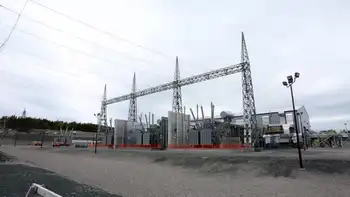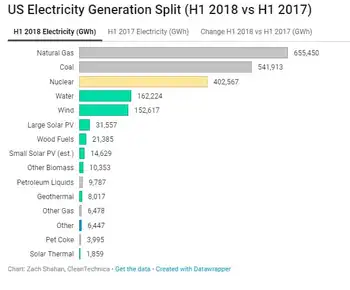Wind energy — too much of a good thing
The real time price of electricity in West Texas, where almost all generation is wind, was negative for 23% of April. The negative prices spilled over to the rest of Texas for about 1% of the month. This may be the future of the electric industry, with negative prices for a substantial amount of time each month.
Various government programs are promoting renewable energy production schemes, such as wind machines, solar cells, and geothermal. These schemes include:
• Tax Credits — Developers receive a discount on their income taxes for investment in renewable energy projects. The tax credits can be based on the amount invested in the project or in the amount of energy produced by the project.
• Renewable Portfolio Standards (RPS) — States require their utilities to produce a stated fraction of their electricity using various types of renewable energy. The definition of utility varies, sometimes including municipally owned utilities, cooperatively owned utilities, marketers, and consumers who produce their own electricity. The definition of renewable varies, sometimes including nuclear, conventional hydro, trash burners, etc.
RPS generally includes a provision for a Renewable Energy Credit (REC) where a utility with a surplus of renewable can sell their compliance to others with a shortage. Some states value one form of renewable at multiples of other forms of renewable, such that RECs may not be fungible across state lines.
The effect of these government programs is a surfeit of renewable energy projects, especially wind projects. Since electricity is fungible, the surfeit of renewable energy projects is creating a surplus of electricity capacity, and sometimes a surplus of the actual production of electricity. Since electricity cannot be easily stored, the surplus can cause operating problems and is driving down the market price for electricity in the competitive markets such as ERCOT, the Electricity Reliability Council Of Texas, which operates the electricity facilities in most of Texas.
ERCOT has identified four different market areas based on the likelihood of transmission constraints between these market areas. The smallest market area is the West market area, which is dominated by wind generation. The capacity of wind generators in the West market area is so great that they occasionally swamp the transmission lines connecting the West market area with the rest of ERCOT. During such times, ERCOT calls upon the generators in the West market area to reduce generation, essentially to dump wind.
Until recently the ERCOT procedure was to actually tell generators in the West market area to dump wind. The wind generators apparently were unhappy with the command and control attitude of ERCOT and sought an economic approach. The current ERCOT approach allows generators in the West market area to bid for access to the transmission lines connecting the West market area to the rest of ERCOT. At least that was effectively the situation for 23% of the time in April 2009. During 664 of the quarter hour periods in April, the price for generation in the West market area was less than zero, with generators paying for the right to dump electricity into the grid. During 28 of those quarter hour periods the negative prices spilled over to other parts of ERCOT.
Renewable energy projects are able to bid negative prices due to the substantial revenue streams they obtain from sources other than ERCOT. A close analogy exists in another renewable energy market, the burning of trash in incinerators to make electricity.
Some incinerators do not have a sufficient volume of trash to produce all of the electricity for which they might be under contractual obligation to produce. The incinerators at such time will buy fossil fuels, such as coal, oil, or natural gas. As much as possible, the incinerators will instead burn trash, charging the trash hauler a tipping fee. Thus, the incinerators will see their fuel cost go from positive to negative depending upon the abundance of trash.
The trash hauler is willing to pay the tipping fee to the incinerator as opposed to the higher cost of owning a sanitary land fill or paying a higher tipping feel at an independently owned land fill. The trash hauler would prefer to be paid by the incinerator for the fuel provided by the trash hauler, but is able to afford the tipping fee because the trash hauler has other sources of revenue in the form of pickup fees. Similarly, renewable energy projects would prefer to be paid for their electricity but can afford to pay for the right to dump their electricity onto ERCOT since they have other sources of revenue.
The migration of extreme electricity prices from one region to another region has been seen in the past. While the ERCOT example is the spread of low prices from the West market area to the rest of ERCOT, the West Coast of North America provided the opposite example in 2000/2001.
The high prices faced by California were passed on by the market to Oregon, Washington, and Canada. Consumers in that area responded, most famously by shutting down aluminum smelters to sell their electrical rights into the California market. This led to higher world prices of aluminum ingots and to higher electricity prices in Venezuela. The electricity supply agreements to the smelters in Venezuela had net back pricing, with the price of electricity determined by the price the smelters received for their ingots.
Related News

N.S. approves new attempt to harness Bay of Fundy's powerful tides
HALIFAX - An Alberta-based company has been granted permission to try to harness electricity from the powerful tides of the Bay of Fundy.
Nova Scotia has issued two renewable energy permits to Jupiter Hydro.
Backers have long touted the massive energy potential of Fundy's tides -- they are among the world's most powerful -- but large-scale commercial efforts to harness them have borne little fruit so far.
The Jupiter application says it will use three "floating barge type platforms" carrying its patented technology. The company says it uses helical turbines mounted as if they were outboard motors.
"Having another company test their technology in…




